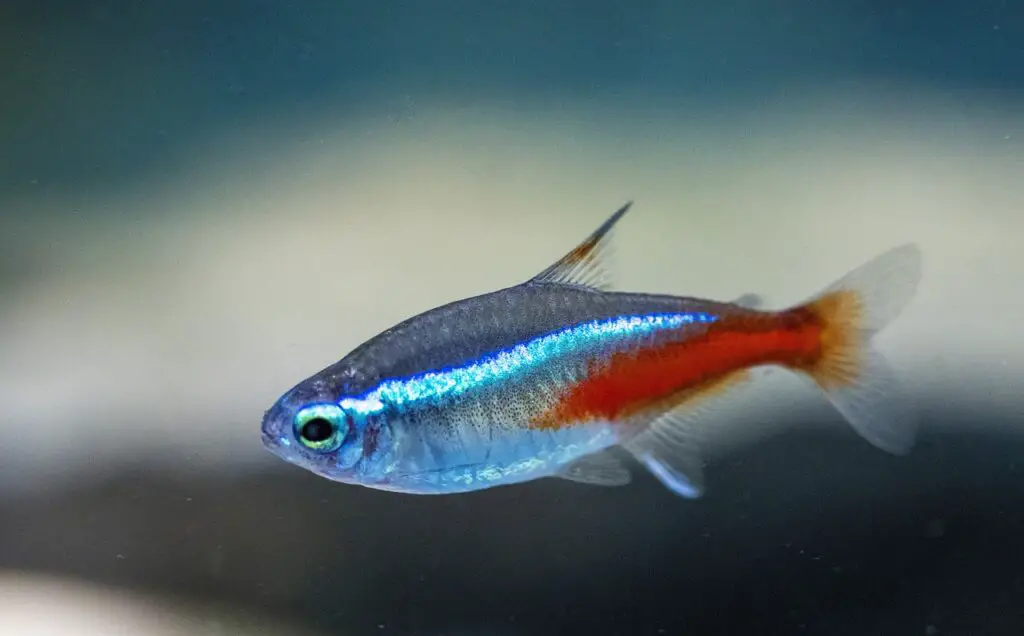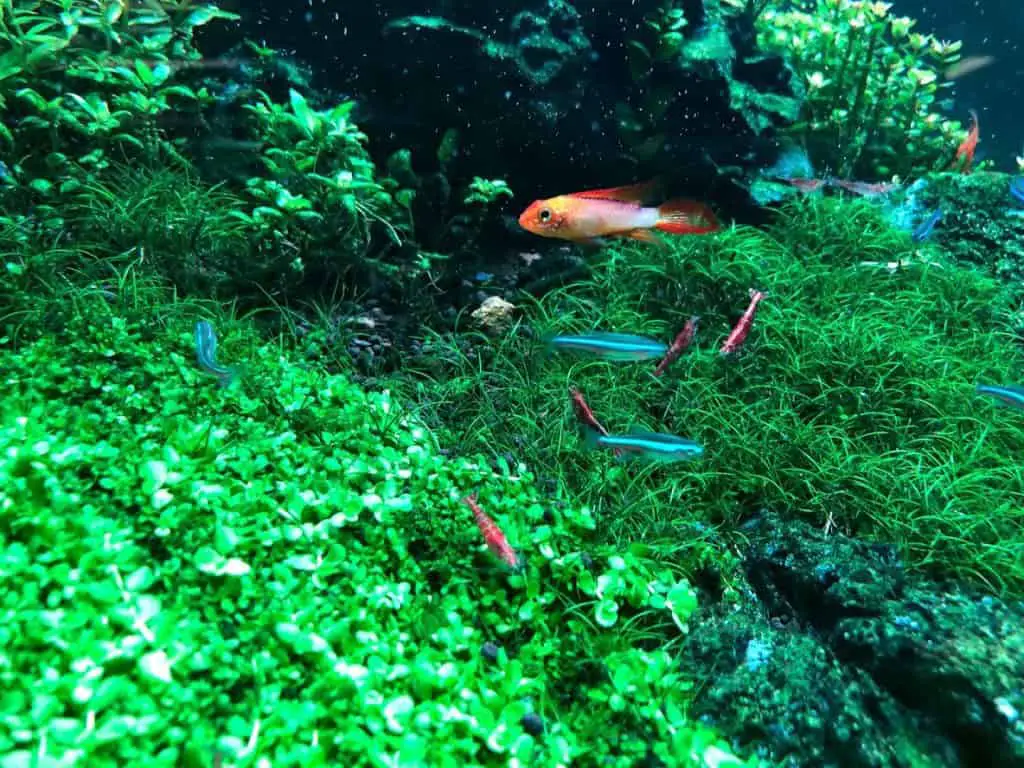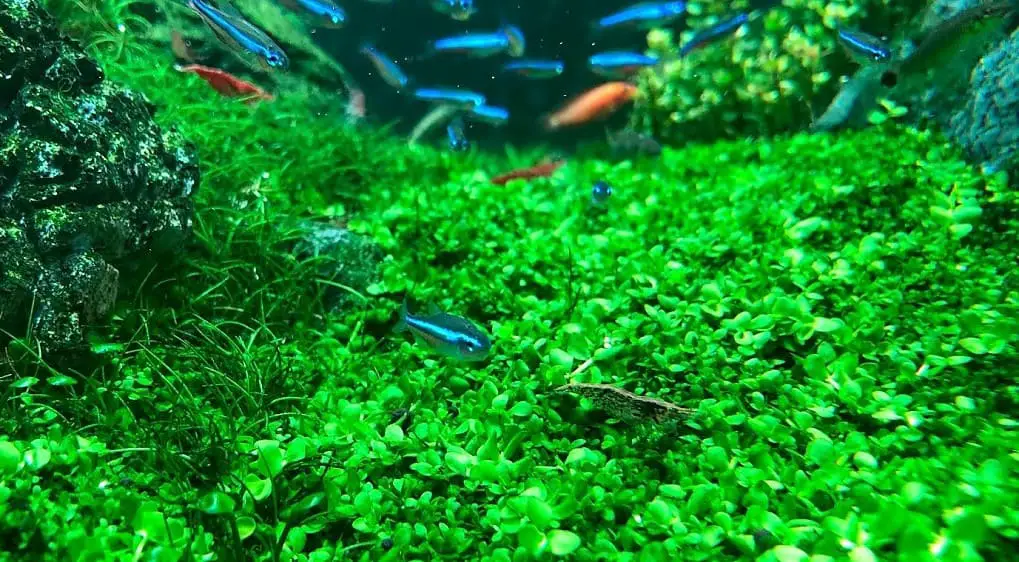One crucial aspect of maintaining a thriving neon tetra community is ensuring that their temperature requirements are met. You see, temperature plays a significant role in the overall health and well-being of these tiny swimmers. It influences their metabolism, immune system function, and even their ability to reproduce.
In this article, we’ll delve into the fascinating world of neon tetras and unveil what science tells us about their ideal temperature range. By understanding and implementing this vital piece of information into your aquarium’s care routine, you’ll be serving your aquatic friends well by providing them with an optimal environment for leading happy, healthy lives.
- Ideal Living Conditions For Neon Tetras
- Tolerance To Water Heat Fluctuations For Neon Tetras
- The Role Of Aquarium Equipment
- Maintaining a Consistent Aquatic Environment
- Factors To Consider For Neon Tetra Fish Health
- Frequently Asked Questions
- Can Neon Tetras Live With Other Fish Species In A Community Aquarium? What Are Some Compatible Tank Mates For Them?
- How Often Should I Feed My Neon Tetras, And What Type Of Diet Is Best For Their Health And Coloration?
- How Can I Ensure Proper Water Quality For My Neon Tetras, And How Often Should I Perform Water Changes?
- What Are Some Common Signs Of Stress Or Illness In Neon Tetras, And How Can I Address These Issues To Ensure The Health Of My Fish?
- How Do I Encourage Breeding Among My Neon Tetras, And What Specific Conditions Do They Require For Successful Reproduction?
- Conclusion
Ideal Living Conditions For Neon Tetras
Imagine the vibrant colors and mesmerizing dance of a school of neon tetras, gracefully swimming in your home aquarium. These beautiful tropical fish have specific requirements to thrive in their environment.
To create the best possible habitat for your neon tetras, let’s explore their ideal living conditions by focusing on the most crucial factor: water temperature.
Neon tetras originate from warm tropical waters; thus, maintaining the right water temperature is crucial for their health and well-being. The minimum water temperature for neon tetras is 68°F (20°C), while the maximum water temperature should not exceed 82°F (28°C). However, the ideal water temperature range for neon tetras is between 72°F (22°C) and 76°F (24°C). Accurate monitoring and regulation can be achieved with an aquarium heater and thermometer, ensuring that your fish are comfortable and thriving.
Aside from water temperature, other factors contribute to creating an optimal environment for neon tetras. Maintaining a pH level between 6.0 and 7.0 will provide them with suitable conditions closer to their natural habitat. Regular water changes are also essential to keep your fish healthy as it helps maintain good water quality by removing harmful substances like ammonia or nitrates produced by waste products.
By carefully considering these factors alongside appropriate temperature ranges, you’ll be able to provide a safe haven for your tropical fish while fulfilling your subconscious desire to serve others by nurturing these captivating creatures in their aquatic sanctuary.

Tolerance To Water Heat Fluctuations For Neon Tetras
Neon tetras, or Paracheirodon innesi, are tropical fish originating from the Amazon region. These small and colorful fish are optimal for community tanks due to their peaceful nature and vibrant appearance. However, it is essential to provide them with a stable environment that closely mirrors their natural habitat to ensure their longevity and maintain neon tetra health issues at bay.
One aspect of neon tetra care involves managing water conditions such as hardness, acidity, temperature fluctuations, and maintaining appropriate nitrite and nitrate levels.
A critical factor influencing the survivability of these delicate fish species is their tolerance to water heat fluctuations. Neon tetras thrive in tropical temperatures ranging between 72-82°F (22-28°C), with a preference for the higher end of this range. To promote neon tetra lifespan and well-being, it is vital to keep the water temperature stable within this range.
Sudden changes in temperature can lead to stress and weaken their immune system, making them more susceptible to diseases. In addition to temperature, maintaining ideal water pH levels between 6.0-7.0 is critical due to their sensitivity toward water acidity.
To fortify your aquarium inhabitants against neon tetra health issues like stress-induced diseases or weakened immunity caused by fluctuating conditions, consider investing in a reliable heater with an integrated thermostat that maintains consistent tropical temperatures within the tank. Concurrently monitor and regulate nitrite and nitrate levels as part of your routine neon tetra care regime while maintaining proper water hardness levels for overall fish health.
If you provide the optimal environmental conditions for your neon tetras, you will be rewarded with vibrant colors, longevity, and healthy fish – all while fulfilling your inherent desire to serve these fascinating creatures that bring life and color into our homes.
The Role Of Aquarium Equipment
Rome wasn’t built in a day, and neither is the perfect environment for your neon tetras. To provide the best possible habitat for your freshwater aquarium pets, it’s essential to understand the role of aquarium equipment in maintaining optimal water temperature and overall living conditions.
A home aquarium requires several key components to ensure that your freshwater fish thrive alongside aquatic plants.
- Heater: Since neon tetras are tropical fish, they require a stable temperature between 72°F to 78°F (22°C – 25°C). Investing in a high-quality heater will help maintain this range consistently, providing comfort and preventing fish diseases caused by sudden temperature fluctuations.
- High-Quality Filter: A powerful filter is crucial for keeping the water clean and free from harmful toxins that can affect the health of your freshwater fish. Moreover, an efficient filtration system helps promote robust growth of aquatic plants.
- Basalt Substrate & Light Source: Neon tetras prefer dimly lit environments, so opt for a soft basalt substrate that absorbs light rather than reflects it. In addition, select a light source that supports both the growth of aquatic plants and enhances the vibrant colors of your neon tetras without causing stress.
I wholeheartedly encourage you to invest time and effort into creating a safe haven for your neon tetras by utilizing appropriate aquarium equipment. Make informed choices about heaters, filters, substrates, and lighting options tailored specifically to meet the needs of these captivating creatures.
Remember that when you take care of even the smallest details in their environment, you contribute not only to their well-being but also to fostering an enriching hobby that brings joy to others who appreciate your dedication and passion for these remarkable freshwater aquarium pets.

Maintaining a Consistent Aquatic Environment
Establishing and maintaining a consistent aquatic environment is crucial to the health and well-being of your neon tetras. These vibrant freshwater fish, including the black neon tetra and green neon tetra, thrive in conditions that closely mimic their native habitat in the Amazon Basin.
I can attest to the importance of providing optimal pet care for these colorful shoaling fish by replicating their natural surroundings as much as possible. This includes maintaining an appropriate temperature for neon tetras as well as simulating the acidic blackwater and clearwater streams found in their South American home.
Freshwater aquariums housing neon tetras should be carefully monitored to ensure a stable environment that meets the specific needs of these delicate swimmers. The ideal temperature for neon tetras typically falls between 68°F (20°C) and 78°F (25°C), with some variation depending on the species. Blackwater habitats are rich in tannins from decaying plant matter provide slightly acidic water with pH levels ranging from 5.0 to 7.0, which is essential for promoting good health among these sensitive creatures. Clearwater streams offer similar conditions but tend to have higher oxygen concentrations, making them equally suitable homes for thriving shoaling fish.
To create an ideal habitat for your vibrant aquatic friends, pay close attention to both water temperature and acidity levels while also mimicking natural lighting patterns that they would experience in the wild Amazon Basin. Simulating dawn and dusk periods will help regulate your pets’ biological clocks, ensuring they remain healthy and active throughout their lives.
By investing time and effort into maintaining consistent aquatic environments that cater specifically to each species’ needs, you’ll not only be providing exceptional pet care but also fostering a deeper connection with these beautiful creatures while supporting their overall well-being.
Factors To Consider For Neon Tetra Fish Health
When it comes to maintaining and ensuring the health of neon tetras, various factors must be given utmost consideration. As a popular species in the ornamental fish trade, these small, vibrant creatures possess iridescent stripes that showcase magnetically controlled iridescence, an attribute that is both visually stunning and indicative of their well-being.
One critical aspect to monitor for neon tetra fish health is the temperature of their environment since they are highly sensitive to fluctuations. Providing the optimal temperature for neon tetras, which generally ranges between 72-78°F (22-26°C), ensures that they thrive and exhibit their characteristic vibrancy.
In addition to temperature regulation, another vital factor to consider when caring for neon tetras involves their diet. As omnivores with a preference for small live or frozen foods such as brine shrimp and daphnia, it is crucial to provide them with a well-balanced diet that caters to their nutritional requirements. Moreover, incorporating high-quality flake food into the neon tetra diet can further enhance their overall nutrition profile and promote good health.
Equally important is understanding how these fish interact in mixed community environments; compatibility with other species such as guppies or similarly sized non-aggressive tankmates is essential in fostering a harmonious aquatic ecosystem.
Taking all of these aspects into account will undoubtedly contribute significantly to the overall health and well-being of neon tetras under your care. By closely monitoring parameters like water quality and temperature while providing an appropriate diet and suitable companionship, you will create an ideal environment where your neon tetras can flourish.
Utilizing your knowledge coupled with a compassionate desire to serve others will ultimately ensure that these beautiful creatures continue to captivate enthusiasts worldwide and remain a treasured staple within the ornamental fish trade for years to come.

Frequently Asked Questions
Can Neon Tetras Live With Other Fish Species In A Community Aquarium? What Are Some Compatible Tank Mates For Them?
When seeking to create a harmonious underwater community, it’s essential to find the right fellow finned friends for your neon tetras.
I can assure you that these vibrant little swimmers can indeed live in harmony with other fish species in a community aquarium.
Compatible tank mates should be peaceful, easy-going, and share similar environmental preferences.
Some ideal companions include guppies, mollies, platies, and even small corydoras catfish.
By introducing these congenial neighbors into your aquarium world, you’re not only ensuring a serene aquatic environment but also fulfilling your innate desire to contribute positively to the lives of these beautiful creatures.
How Often Should I Feed My Neon Tetras, And What Type Of Diet Is Best For Their Health And Coloration?
Neon tetras thrive when fed a varied and balanced diet, which not only keeps them healthy but also enhances their beautiful colors.
I recommend feeding your neon tetras small portions two to three times a day, ensuring that they can consume the food within a few minutes to prevent overfeeding and water pollution.
Incorporate high-quality flake or pellet food as their staple diet, supplemented with live or frozen foods such as brine shrimp, daphnia, and bloodworms.
This diverse diet will provide the essential nutrients for their overall well-being and contribute to a happy community aquarium environment where you can take pride in serving these vibrant little creatures.
How Can I Ensure Proper Water Quality For My Neon Tetras, And How Often Should I Perform Water Changes?
To keep your neon tetras swimming in crystal-clear waters, maintaining proper water quality is a crucial piece of the puzzle.
I recommend testing your aquarium’s water parameters regularly to ensure the pH level stays between 6.0 and 7.0, as well as monitoring ammonia, nitrite, and nitrate levels.
A balanced diet contributes to maintaining good water quality; however, it’s also essential to perform regular water changes – ideally, around 20-25% every week or two.
This not only helps maintain optimal conditions for your little swimmers but also aligns with our innate desire to care for others and create a thriving environment for them to flourish in.
Remember, happy fish make happy aquarists!
What Are Some Common Signs Of Stress Or Illness In Neon Tetras, And How Can I Address These Issues To Ensure The Health Of My Fish?
In our quest to provide the best care for our vibrant little friends, it’s crucial to recognize and address signs of stress or illness in neon tetras.
Some common indicators include loss of color, erratic swimming behavior, clamped fins, isolation from the group, and visible spots or growths on their bodies.
If you notice any of these symptoms, promptly assess your tank’s water quality and temperature to ensure they’re within the ideal range for neons.
Additionally, consider isolating sick fish in a separate quarantine tank to prevent potential disease spread among the group.
By keeping a watchful eye on our finned companions and addressing any health concerns with diligence and empathy, we can help them flourish in their aquatic environment.
How Do I Encourage Breeding Among My Neon Tetras, And What Specific Conditions Do They Require For Successful Reproduction?
To encourage breeding among your neon tetras, it’s essential to create an ideal environment that mimics their natural habitat and supports successful reproduction.
Start by setting up a separate breeding tank with soft, slightly acidic water (pH 5-6), a dimly lit atmosphere, and plenty of fine-leaved plants or spawning mops for the fish to lay their eggs on.
Gradually raise the temperature to 77-81°F (25-27°C) as warmer conditions often stimulate spawning behavior. Additionally, provide high-quality live or frozen foods to boost the fish’s overall health and conditioning.
Once you observe courtship displays – where males chase females around the tank – gently transfer a well-conditioned pair or small group into the breeding tank in the evening, as neon tetras usually spawn at dawn.
Bear in mind that patience is key; sometimes, multiple attempts are necessary before successful breeding occurs. And don’t forget to promptly remove adult fish after spawning to prevent them from consuming their eggs!
Conclusion
In conclusion, it’s essential to provide our little-finned friends with the utmost care and attention, ensuring their environment is conducive to both their physical and emotional well-being.
By being attentive to their dietary needs, compatible tank mates, and optimal water conditions, we can contribute to the vibrant colors and vivacity of these aquatic gems.
I cannot emphasize enough the importance of understanding the signs of stress or illness in neon tetras.
When one takes the time to foster a nurturing environment for breeding, it’s truly rewarding to witness the delicate dance of life as new generations emerge.
Let us strive to create a harmonious underwater world where these dazzling creatures can thrive.
